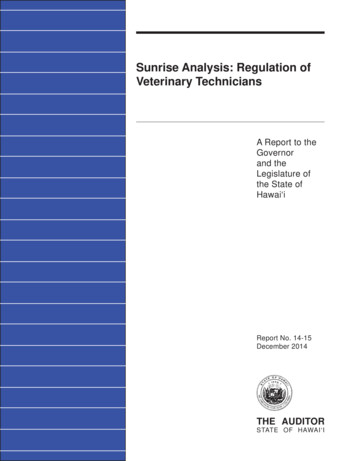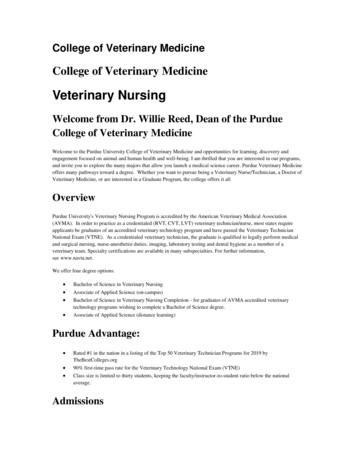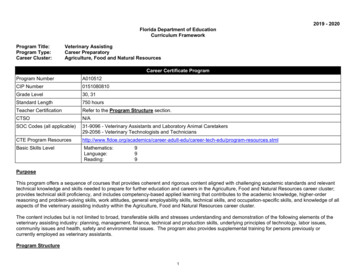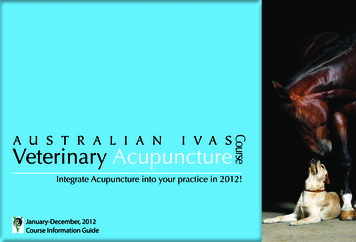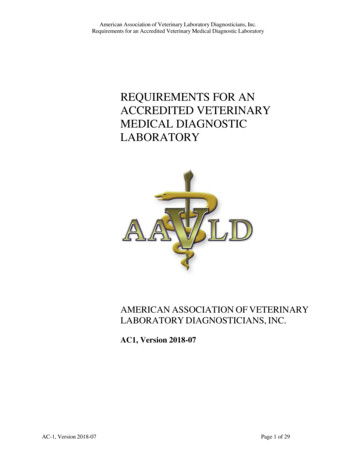
Transcription
American Association of Veterinary Laboratory Diagnosticians, Inc.Requirements for an Accredited Veterinary Medical Diagnostic LaboratoryREQUIREMENTS FOR ANACCREDITED VETERINARYMEDICAL DIAGNOSTICLABORATORYAMERICAN ASSOCIATION OF VETERINARYLABORATORY DIAGNOSTICIANS, INC.AC1, Version 2018-07AC-1, Version 2018-07Page 1 of 29
American Association of Veterinary Laboratory Diagnosticians, Inc.Requirements for an Accredited Veterinary Medical Diagnostic LaboratoryTable of ContentsPageMission Statement . 3Objectives of the Accreditation Program. 3Classification . 4Administrative Requirements . 42.1 Organization, Management and Personnel . 42.2 Finance and Budget . 4Accreditation Process . 4Specific Requirements . 5Management Requirements . 54.1 Organization and Management . 54.2 Quality System . 64.3 Document Control . 74.4 Review of request or contract . 74.5 Subcontracting of test services . 84.6 Purchasing services and supplies . 84.7 Complaints . 84.8 Control of nonconforming testing and test results . 84.9 Corrective and Preventative Action . 94.10 Records . 94.11 Internal audits . 104.12 Management reviews . 11Technical Requirements. 115.1 General. 115.2 Personnel . 125.3 Accommodations and environmental conditions . 125.4 Test Methods . 125.5 Equipment. 165.6 Measurement Traceability. 175.7 Specimens . 175.8 Handling of Specimens . 185.9 Ensuring the quality of test results . 185.10 Reporting test results . 19Document Revision Summary . 20Appendix 1: Personnel Qualifications .22Appendix 2: Glossary of Terms 25AC-1, Version 2018-07Page 2 of 29
American Association of Veterinary Laboratory Diagnosticians, Inc.Requirements for an Accredited Veterinary Medical Diagnostic LaboratoryMISSION STATEMENTThe purpose of the AAVLD accreditation program is to accredit public veterinary diagnosticlaboratories in North America relative to technical and operational competence compatible withappropriate standards and to provide an administrative assessment.OBJECTIVES OF THE ACCREDITATION PROGRAM To provide a mechanism for objectively accrediting veterinary diagnostic laboratories To continuously emphasize the importance of excellence in veterinary diagnostic service To periodically evaluate and modify the accreditation process To keep laboratories cognizant of current technological advances in diagnostic veterinarymedicine To keep laboratories informed of the impact of legislative mandates and other regulatoryactions To promote adequate training of specialists in diagnostic veterinary medicine To encourage hiring of dedicated and innovative diagnosticians with appropriate trainingand experience To encourage acquisition and maintenance of facilities suitable and adequate to providequality services To promote appropriate quality system programs To assist laboratories to meet or exceed the standards of the World Organization forAnimal Health (Office International des Epizooties) (OIE) described in the OIE QualityStandard and Guidelines for Veterinary Laboratories: Infectious Diseases, 2008AC-1, Version 2018-07Page 3 of 29
American Association of Veterinary Laboratory Diagnosticians, Inc.Requirements for an Accredited Veterinary Medical Diagnostic LaboratoryCLASSIFICATION1.11.21.3There are two types of accreditation: accredited and provisionally accredited.An accredited laboratory is one that is capable of providing a full range of diagnosticservices year-round in a majority of the following essential disciplines: necropsy,histopathology, clinical pathology, bacteriology, virology, mycology, parasitology,serology and toxicology. It is mandatory that a full service laboratory offer necropsy,histopathology, bacteriology, and virology on site. Mechanisms must exist for referral ofthose services not directly offered by the laboratory. The Accreditation Committee willevaluate the appropriateness of essential services referred to other laboratories.A provisionally accredited laboratory is one that does not meet the requirements andguidelines but shows intent to do so. A provisionally accredited laboratory is given aperiod of time to correct the deficiencies noted. Provisionally accredited laboratories arerequired to document progress through periodic reports.ADMINISTRATIVE REQUIREMENTS2.1Organization, Management and Personnel2.1.1Diagnostic laboratories reviewed for accreditation may be administered by aState/Provincial Department of Agriculture, a University, an Agricultural ExperimentStation, a State/Provincial Department of Health, or by various combinations of suchpublic institutions. The Committee does not review commercial laboratories orlaboratory animal diagnostic laboratories supported by the National Institutes of Health.2.1.2 The laboratory personnel shall be able to provide competence in all management andtechnical groups evaluated for accreditation. Minimum training levels are listed bylaboratory position in Appendix 1, Personnel Qualifications.”2.2Finance and Budget2.2.1The overall budget will be evaluated on the basis of salaries for personnel, operations,equipment, maintenance, travel, information technology and continuing education. Thelaboratory shall have sufficient resources to meet the requirements for accreditation asindicated in the support for the various disciplines and the overall administrative functionof the laboratory.2.2.2 As diagnostic laboratories are a vital part of disease surveillance and monitoring, financesmust be available to sustain these assignments. Since these laboratories serve the publicgood, surveillance resources are not intended to be self-sufficient financially and requirepublic financial support commensurate with the public good derived.ACCREDITATION PROCESS3.1The Accreditation Committee will consider all written applications for an accreditationsite visit from qualifying public laboratories, as described in the administrativerequirements.AC-1, Version 2018-07Page 4 of 29
American Association of Veterinary Laboratory Diagnosticians, Inc.Requirements for an Accredited Veterinary Medical Diagnostic Laboratory3.23.3The Accreditation Committee of the American Association of Veterinary LaboratoryDiagnosticians will evaluate each laboratory in terms of the degree to which it meets itsown statement of objectives and the established criteria set by the AccreditationCommittee.Each accredited laboratory will be requested to provide an annual update at the time ofdues payment that outlines changes in Chief Administrator or administrative structure, orany major changes in personnel, physical facilities, equipment, or budget that could affectaccreditation status.3.4Steps of the Accreditation process:3.4.13.4.2Application. Applications are considered confidential by the Committee.The Accreditation Committee reviews the application and the laboratory’s QualityManagement System documents. If the status, application and QualityManagement System of the laboratory are satisfactory, a site visit will beperformed.A site visit will be conducted according to the Accreditation Site Visit Guidelines setforth by AAVLD.The site visit team provides written and oral reports and recommendations to theAccreditation Committee.The Committee may make changes to the written report and recommendations anddetermines the classification status of the laboratory.Reports, which are considered as confidential information, are sent to the laboratorydirector.Accreditation is time limited. Laboratories are reaccredited periodically throughreapplication. Accreditation may be withheld or withdrawn if the laboratory fails tomeet the Requirements of the AAVLD Accreditation Committee.3.4.33.4.43.4.53.4.63.5SPECIFIC REQUIREMENTS4.Management Requirements4.1Organization and Management4.1.1The laboratory or the organization of which it is part shall be an entity that can be heldlegally responsible.4.1.2 The laboratory shall be organized and shall operate in such a way that it meets therequirements of this Standard whether carrying out work in its permanent facilities, atsites away from its permanent facilities or in associated temporary or mobile facilities.4.1.3 The laboratory shall have a clearly defined organizational system and structure. Thisshall be supported with organizational charts and job descriptions. Organizational chartsshall indicate key personnel and the laboratory’s place within the larger organization.Relationships between management, technical operations, support services and qualityactivities shall be specified.AC-1, Version 2018-07Page 5 of 29
American Association of Veterinary Laboratory Diagnosticians, Inc.Requirements for an Accredited Veterinary Medical Diagnostic Laboratory4.1.4The laboratory shall:a) have managerial and technical personnel with the authority and resources needed tocarry out their duties and to identify the occurrence of departures from the qualitysystem or from the procedures for performing tests and to initiate actions to preventor minimize such departures;b) have arrangements to ensure that its management and personnel are free from anyundue internal or external commercial, financial or other pressures and influences thatmay adversely affect the quality of their work;c) have policies and procedures to ensure the protection of its clients’ confidentialinformation and proprietary rights, including procedures for protecting the electronicstorage and transmission of results;d) have policies and procedures to avoid involvement in any activities that woulddiminish confidence in its competence, impartiality, judgment or operationalintegrity;e) specify the responsibility, authority and inter-relationships of all personnel whomanage, perform or verify work affecting the quality of the tests;f) provide adequate supervision of testing staff, including trainees, by persons familiarwith the tests, their purpose and the analysis of test results;g) have technical management which has overall responsibility for the technicaloperations and the provision of the resources needed to ensure the required quality oflaboratory operations;h) appoint a member of staff as quality manager (however named) who, irrespective ofother duties and responsibilities, shall have defined responsibility and authority forensuring that the quality system is implemented and followed at all times; the qualitymanager shall have direct access to the highest level of management at whichdecisions are made on laboratory policy or resources;i) appoint backups or deputies for key managerial personnel such as the qualitymanager.NOTE: In laboratories with a small number of personnel, individualsmay have more than one function, and it may be impractical to appointdeputies for every function.4.2Quality system4.2.1The laboratory shall establish, implement and maintain a quality system appropriate tothe scope of its activities, including the type, range and volume of testing it undertakes.The laboratory management shall document its policies, systems, programs, proceduresand instructions to enable the laboratory to ensure to the extent possible, the quality of thetest and diagnostic interpretations it generates. Documentation used in this qualitysystem shall be communicated to, understood by, available to and implemented by theappropriate personnel.4.2.2 The laboratory management shall define and document the policies and objectives to beachieved by implementing the quality system. The laboratory management shall ensurethat these policies and objectives are documented in a quality manual. The overallobjectives shall be set out in a quality policy statement in the quality manual, stating theAC-1, Version 2018-07Page 6 of 29
American Association of Veterinary Laboratory Diagnosticians, Inc.Requirements for an Accredited Veterinary Medical Diagnostic Laboratorystandard of performance to be achieved and maintained. The quality policy statementshall be issued under the authority of the chief executive. It shall include at least thefollowing:a) a statement of the laboratory management’s intentions with respect to the standard ofservice it will provide;b) the purpose of the quality system;c) a requirement that all laboratory personnel familiarize themselves with the qualitydocumentation and implement the policies and procedures in their work;d) the laboratory management’s commitment to good professional practice and qualityof its diagnostic services to its client; ande) the laboratory management’s commitment to compliance with the AAVLD Standard.NOTE: The quality policy statement and manual should be concise.4.2.34.2.4The quality manual shall include or make reference to the supporting procedures,including technical procedures. It shall outline the structure of the documentation used inthe quality system. The quality manual shall be maintained up to date.The quality manual shall define the roles and responsibilities of technical managementand the quality manager, including their responsibility for ensuring compliance with theAAVLD Standard.4.3Document Control4.3.1The document control system shall ensure that only the current version of the correctdocument is in use in the laboratory and that documents needed for staff to perform theirwork are available at the work location.The laboratory shall have documented policy, procedures and/or work instructions thatdescribe how laboratory documents affecting the quality of tests, including test methods,are reviewed, approved, issued, updated, revised, amended, retained or archived anddiscarded. Procedures shall be reviewed and approved by authorized, qualified staff.Changes to documents shall be identified clearly and reviewed and approved by anauthorized, qualified officer, administrator or supervisor having access to pertinentbackground information concerning the change.Documents shall be uniquely identified and accurately cross-referenced.Documents shall include page numbers and total number of pages or a mark to signify theend of the document,4.3.24.3.34.3.44.3.5NOTE: In this context “document” means any information orinstructions, in any format or medium, that have direct bearing on oraffect the quality of test results and includes not only the quality manual,policy, procedures and instructions, but also test methods, worksheets,forms, international standards and regulations.4.4Review of request or contractAC-1, Version 2018-07Page 7 of 29
American Association of Veterinary Laboratory Diagnosticians, Inc.Requirements for an Accredited Veterinary Medical Diagnostic Laboratory4.4.14.4.2The laboratory shall have documented policy and procedures that describe how thelaboratory ensures that it is capable of and has the capacity for doing particular testing.The procedures shall ensure adequate review of the proposed work with laboratory staffand the client. The laboratory shall keep a record of the review and of client agreement.The review shall also cover any work that is subcontracted or referred by the laboratory.NOTE: Please refer to the AAVLD Glossary of Terms for definitions ofSubcontracted and Referral tests.4.5Subcontracting of test services4.5.1When a laboratory offers tests that are subcontracted, whether because of unforeseenreasons (e.g. workload, need for further expertise or temporary incapacity) or on acontinuing basis (e.g. through permanent subcontracting or agency arrangements), thiswork shall be placed with a competent subcontractor. A competent subcontractor is onethat, for example, complies with the AAVLD Requirements or ISO 17025 for the work inquestion.4.5.2 The laboratory shall advise the customer of the arrangement.4.5.3 The laboratory is not responsible for documenting that the subcontracting lab is competentwhen the customer or a regulatory authority specifies which subcontractor is to be used.4.5.4 The laboratory shall maintain a list of all subcontractors that it uses for tests.NOTE: Referral tests (as defined by the AAVLD Glossary of Terms) does not fallunder section 4.5 (Subcontracting of Test Services). Refer to AAVLD 4.4 (Reviewof Request and Contract).4.6Purchasing services and suppliesThe laboratory shall have a policy and procedures to ensure that services and supplies meet preestablished specifications and will not adversely affect the quality of test results. Theseprocedures shall include a description of the criteria for selection, evaluation, use, handling andstorage of materials and reagents having an effect or potential effect on test results.4.7ComplaintsThe laboratory shall have a policy and procedure for the resolution of complaints received fromclients or other parties. Records shall be maintained of all complaints and of the investigationsand corrective actions taken by the laboratory.4.8Control of nonconforming testing and test results4.8.1The laboratory shall have a policy and procedures that ensure that nonconforming testing(conditions that exist which have or could adversely affect the reliability of test results) isdetected and promptly corrected. The laboratory shall have procedures for informingclients if test results are questionable or incorrect, particularly if this possibility isidentified after test results have been reported to the client. These procedures shalldescribe who has the authority to withhold test results, implement corrective action andauthorize resumption of work.AC-1, Version 2018-07Page 8 of 29
American Association of Veterinary Laboratory Diagnosticians, Inc.Requirements for an Accredited Veterinary Medical Diagnostic Laboratory4.8.2When a serious issue or a risk to the quality of test results is identified, the laboratoryshall ensure that appropriate corrective action procedures given in 4.9 shall be promptlyimplemented.4.9Corrective and preventive action4.9.1The laboratory shall have a policy and procedures for implementing corrective actionwhen nonconforming work or departures from the policies and procedures in the qualitysystem have been identified. The policy and procedures shall ensure:a) designation of appropriate authorities responsible for implementation of correctiveaction(s);b) investigative procedures are implemented to determine the root cause(s) of theproblem;c) upon identification, appropriate corrective action(s) are implemented;d) documentation of any required changes to operational procedures;e) once implemented, corrective action(s) are monitored to ensure effectiveness inovercoming the problem; andf) when appropriate, areas of activity subject to corrective action are audited inaccordance with 4.11.NOTE: Special internal audits need only be initiated when a seriousissue or risk to the quality of test results or integrity of the quality systemhas been the subject of corrective action.4.9.2The laboratory shall identify potential sources of nonconformance and potential needs forimprovement, either technical or with the quality system. Preventive action proceduresshall include:a) identification and evaluation of potential nonconformance or improvement;b) development and implementation of an action plan, including appropriate controls;andc) monitoring of effectiveness in reducing likelihood of nonconformance or inaddressing specific needs for improvement.NOTE: Preventive action is a pro-active process. Identification ofspecific technical areas requiring preventive action often involves theongoing monitoring and review of the validity of the test methods andthe competence of the laboratory.4.10RecordsAll laboratory records must be maintained in an effective retrieval system and must beaccurate, contemporaneous, attributable and legible. This retrieval system should includea system of classification of diseases. Records should be preserved in accordance withrequirements for individual jurisdictions.AC-1, Version 2018-07Page 9 of 29
American Association of Veterinary Laboratory Diagnosticians, Inc.Requirements for an Accredited Veterinary Medical Diagnostic Laboratory4.10.1 GeneralThe laboratory shall have a records management system.4.10.1.1The laboratory shall establish and maintain procedures for identification, collection,indexing, access, storage, maintenance and disposal of quality and technical records.Quality records shall include reports from internal audits and management reviews, aswell as, corrective and preventive action records.4.10.1.2All records shall be legible and shall be stored and retained in such a way that they arereadily retrievable in facilities that provide a suitable environment to prevent damage ordeterioration and to prevent loss. Retention times of records shall be established.NOTE: Records may be in the form of various types of media, such ashard copy or electronic media.4.10.1.3All records shall be held secure and in confidence.4.10.1.4The laboratory shall have procedures to protect and back up data and records held oncomputers at all times and to prevent unauthorized access to or amendment of data orrecords on computers.4.10.2 Technical records4.10.2.1The laboratory shall retain for a defined period of time original observations, deriveddata, calibration records, staff records, a copy of each test report issued and any otherinformation necessary to recreate the activity. The records for each test shall containsufficient information to facilitate identification of factors affecting the quality of testresults and to enable the test to be repeated under conditions as close as possible to theoriginal. The records shall include the identity of personnel.4.10.2.2Observations, data and calculation shall be clearly and permanently recorded andidentifiable to the specific test at the time they are made.4.10.2.3When mistakes occur in records, each mistake shall be crossed out (not erased, madeillegible or deleted) and the correct value entered alongside. All such alterations torecords shall be dated, signed or initialed by the person making the correction. In thecase of computer collected data, similar measures shall be taken to avoid loss or changeof original data.4.11Internal audits4.11.1 The laboratory shall periodically and in accordance with a predetermined schedule andprocedure, conduct internal audits of its activities to verify that its operations continue tocomply with the requirements of the quality system and the AAVLD Standard. Theinternal audit program shall address all elements of the quality system, including testingactivities. It is the responsibility of the quality manager to plan and organize audits asrequired by the schedule and requested by management. Such audits shall be carried outby trained and qualified personnel who are, wherever resources permit, independent ofAC-1, Version 2018-07Page 10 of 29
American Association of Veterinary Laboratory Diagnosticians, Inc.Requirements for an Accredited Veterinary Medical Diagnostic Laboratorythe activity to be audited. Personnel shall not audit their own activities, except when itcan be demonstrated that an effective audit can be carried out.NOTE: In laboratories with a small number of personnel, effectiveinternal audits may not be feasible. In such cases, it may be appropriatefor two or more laboratories to cooperate in auditing each other.4.11.2 When audit findings cast doubt on the effectiveness of the operations or on the quality ofthe laboratory’s test results, the laboratory shall take timely and effective corrective andwhere appropriate preventive action, and shall notify clients in writing if investigationsshow that the laboratory results may have been affected (see 4.8).4.11.3 The area of activity audited, the audit findings and corrective actions that arise from themshall be recorded. The laboratory management shall ensure that these corrective actionsare discharged within an appropriate and agreed-upon time frame.4.12Management reviews4.12.1 The quality system and test related activities shall be reviewed by management at leastonce per year.4.12.2 The laboratory shall have a procedure for performing a Management Review. The reviewshall take into consideration:a) suitability of policies and procedures;b) reports from managerial and supervisory personnel;c) reports of recent internal audits;d) corrective and preventive actions;e) assessments by external bodies;f) results of inter-laboratory comparisons or proficiency tests;g) changes in the volume and type of work;h) client feedback;i) complaints;j) other relevant factors, such as quality control activities, resources and staff training.4.12.3 Findings from management reviews and the actions that arise from them shall berecorded. The management shall ensure that those actions are discharged within anappropriate and agreed-upon time frame.4.12.4 This review and subsequent activities shall ensure the continuing suitability andeffectiveness of the quality management system and shall ensure the introduction ofnecessary changes and improvements.5.Technical requirements5.1General5.1.1Many factors can affect the reliability of test results. The extent to which these factorscontribute to the reliability of test results differs between tests. The laboratory shall takeaccount of these factors in developing or adopting test methods and related proceduresfor routine use, in the training and qualification of personnel, in the selection andAC-1, Version 2018-07Page 11 of 29
American Association of Veterinary Laboratory Diagnosticians, Inc.Requirements for an Accredited Veterinary Medical Diagnostic Laboratorycalibration of equipment and in the assessment of materials and reagents to be used intesting.5.2Personnel5.2.1The laboratory shall ensure the initial and ongoing competence of all laboratorypersonnel to do their assigned work using objective criteria. Note: Examples of objectivecriteria may include proficiency testing, inter-laboratory comparisons, reference samplepanels, replicate testing of quality control materials and continuing education.5.2.2 The laboratory shall maintain current job descriptions for managerial, technical and keysupport personnel involved in testing and diagnostic interpretation, and the managementshall authorize only staff that is documented as qualified and competent to do testing andrelated work.5.2.3 The laboratory shall have a system that ensures the establishment and maintenance of atraining program relevant to the present and anticipated needs of the on and environmental conditionsAll aspects of the physical facilities must provide an appropriate environment for theconduct of the activities of all disciplines required for laboratory accreditation.Laboratories, offices, storage space and animal holding rooms shall be clean, maintainedin good repair and be adequate in number and size for the intended function of thelaboratory. Adequate lighting and ventilation shall be provided. Safety, biosafety,biocontainment and biosecurity features shall be incorporated as a part of the physicalfacility.Laboratory facilities for testing, including but not limited to energy sources, lighting andenvironmental conditions, shall be such as to facilitate correct performance of tests. Thelaboratory shall ensure that the environment does not invalidate the results or adverselyaffect the required quality of any te
American Association of Veterinary Laboratory Diagnosticians, Inc. Requirements for an Accredited Veterinary Medical Diagnostic Laboratory . 4.1.4 The laboratory shall: a) have managerial and technical personnel with the authority and resources needed to carry out their duties and to identify the occurrence of departures from the quality

